The Difference Between Speech vs Language Disorders
As a speech-language pathologist, you know there are many differences between speech vs language disorders. A student can present with either or both types of disorders.
This blog post will give you tons of tips, tricks, and resources you can share with classroom teachers to help them understand the difference between speech vs language disorders.
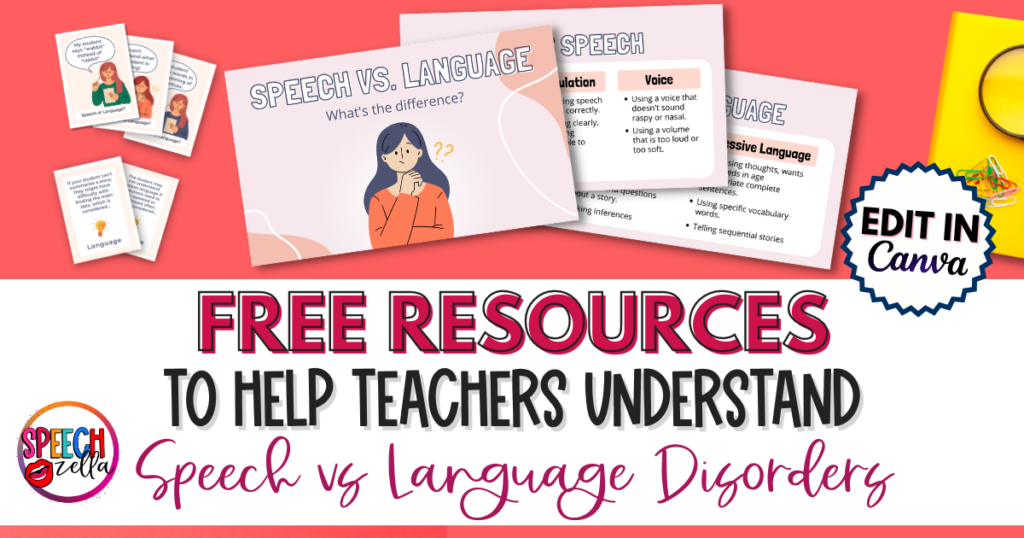
When working in a school, these language or speech disorders can be missed by teachers and parents.
Have you ever encountered any of these situations?
- A student is working at grade level, but has a really hard time expressing themselves in complete sentences.
- A student is performing well academically but needs directions to be repeated and rephrased often.
- A student loves to socialize and respond to questions in class, but it seems like they constantly repeat sounds and words.
We know these students probably struggle with speech, language problems, or both! But, I’ve heard many teachers say, “I’m just not sure what is going on with my student… They are working on grade level, but they are still struggling.”
Have you ever wished there was an easy way to help your teachers identify the signs early on and get their students the help they need?
I have 7 resources you could use today to get you started when you continue reading!
Why is it important to understand speech vs language disorders?
Teachers should understand the differences between a child's speech and language, so they can better support young students with these communication problems.
Research suggests that students with speech and language disorders are more at risk of struggling academically and receiving poor grades. These students might also experience low self-esteem, low confidence, and poor socialization skills.
But what is the best way to help teachers learn about speech vs language disorders?
Continue reading to get all the free resources below…
How can teachers identify students who might have a speech or language disorder?
With these free resources, you can help teachers understand the subtle difference between speech vs language disorders.
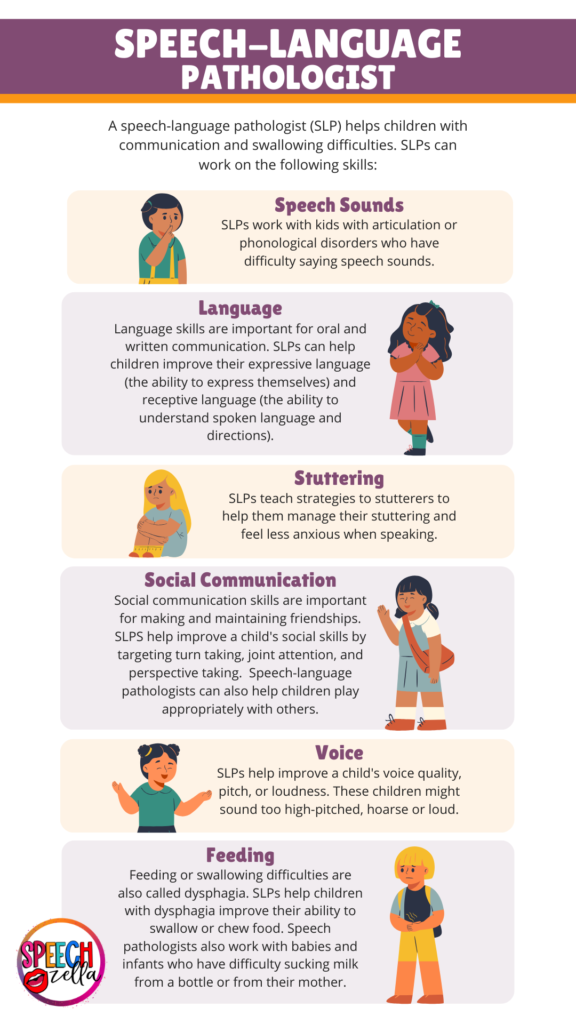
For example, some of the problems these children might have are:
- Reading below grade level
- Working at a slower pace
- Unable to initiate or maintain a conversation.
- Unintelligible speech
- Difficulty understanding spoken or written directions.
- Poor social skills
- Using complete sentences and age-appropriate vocabulary.
I have 7 FREE resources to help you support teachers in understanding the differences between speech and language. But first, let’s talk about speech and language disorders and what they look like in the classroom.
What are the causes of speech vs language disorders?
Speech and language disorders in children can have a variety of causes (and sometimes have no cause at all!). Communication problems can be caused by the following categories:
Developmental Language Disorder (DLD)
According to the American Speech-Language-Hearing Association (ASHA), DLD is a neurodevelopmental difference that is brain-based, such as autism spectrum disorder or dyslexia. DLDs are not caused by intellectual impairments, syndromes, or medical issues.
These developmental disorders can affect various aspects of language, from understanding (receptive language) to speaking (expressive language). Providing early intervention for these children is crucial to help them communicate!
Genetics
Some speech and language disorders have a genetic component. These disorders are more likely to occur in families that already have members with similar speech and language challenges.
Hearing Loss
Even a small hearing loss can make it difficult for kids to understand the speech of others, which can also affect expressive language. Catching a hearing loss early and getting help is important. That's why school nurses and private practices conduct hearing screenings on a regular basis.
Neurological Disorders:
Cerebral palsy or traumatic brain injury can lead to speech and language difficulties. These disorders can affect brain development and function, such as muscle control, cognitive processing, memory, and attention.
Environmental Factors
To develop speech and language skills, young children need a language-rich environment at school, as well as at home. If they don't attention at home or socialize with their same-aged peers, they might struggle to express themselves and understand language.
Intellectual Disabilities
Children with intellectual disabilities may experience delayed or impaired speech and language development. In severe cases, the student may not be able to speak or understand language.
Socio-Economic Factors
Economic stress, time management, and the use of electronics might reduce the parents' ability to spend time talking and doing fun, helpful language-rich activities. Families with economic challenges might not have easy access to books or educational toys that can stimulate language development.
Social and Emotional Issues
Social anxiety or emotional trauma can affect speech and language development. Students might have difficulty with fluency or the willingness to communicate.
Function and Structure of the Speech Parts
Physical problems, like cleft palate and teeth misalignment, can make it hard to make speech sounds correctly. The function of the muscles of the face could also be impaired.
Motor Speech Disorders
A motor speech disorder happens when the brain has difficulty coordinating or controlling the muscles and movements needed to produce speech. Children with apraxia of speech know what they want to say, but their brains have difficulty coordinating the muscle movements necessary to say those words.
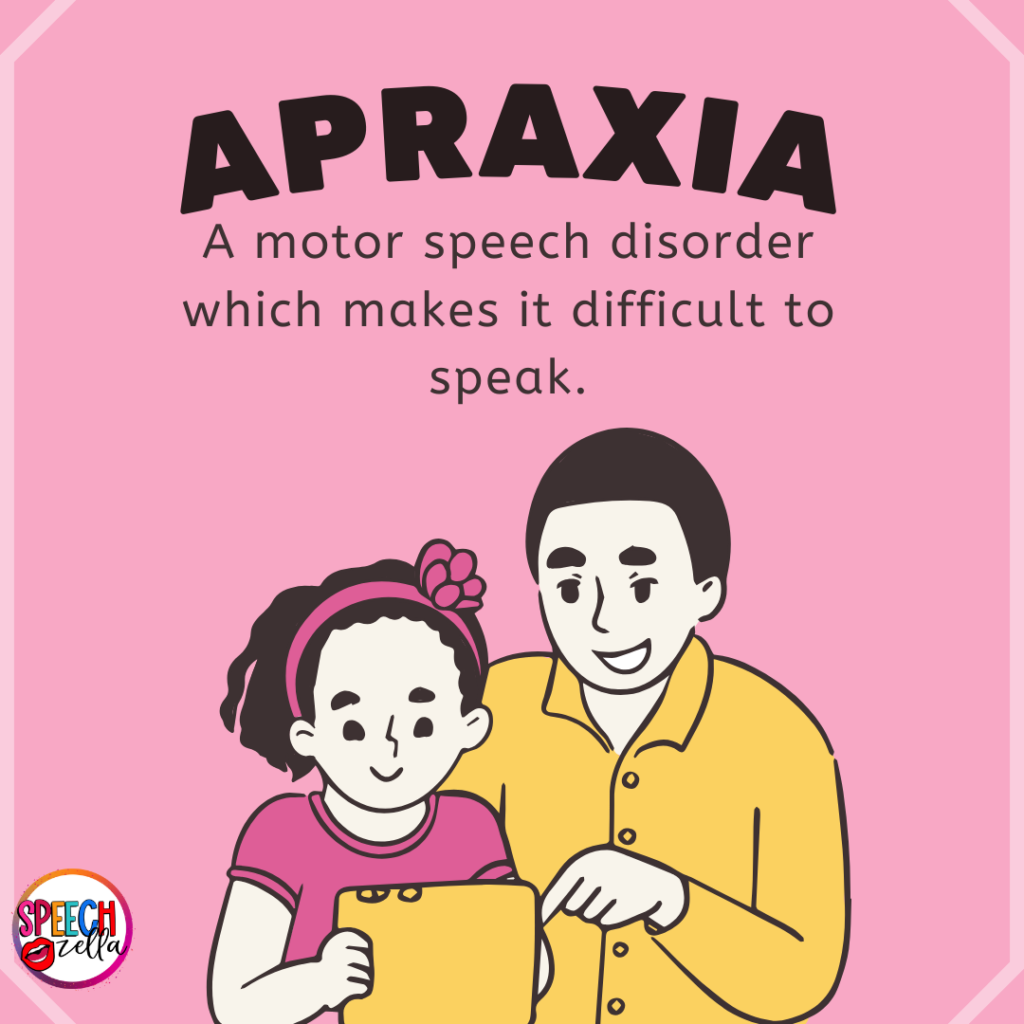
Language Processing Disorders
Some children may have difficulty understanding and processing language. These processing disorders can impact both receptive and expressive language abilities.
What are speech disorders?
Three areas could indicate a student has a speech disorder: articulation, fluency, and voice.
Articulation Disorders
Students with articulation disorders have difficulty producing speech sounds or exhibit phonological processes that should have resolved at an earlier age. When teachers refer students due to articulation disorders, they might make comments, such as:
- I can’t understand what my student is saying.
- He has trouble with specific sounds.
- When speaking, his words don’t sound right.
- The student sounds like he is mumbling.
- Sometimes she doesn’t say all the sounds in a word.
- When reading, my student doesn’t say all the syllables in a word.
What can you tell teachers about articulation disorders?
When presented with these statements, it is important to listen to the teacher and acknowledge their concerns.
Here are some statements we can say:
- You can't understand your student. Do you mean that he is not using complete sentences, appropriate vocabulary, and grammar? Or do you think the student is not saying the sounds in the words correctly?
- His words don't sound right. Do you mean he is not using the right vocabulary or that he doesn’t use the correct sound in his words?
- Your student is mumbling. Is he speaking too softly? If so, what happens when you ask your student to speak louder or slower?
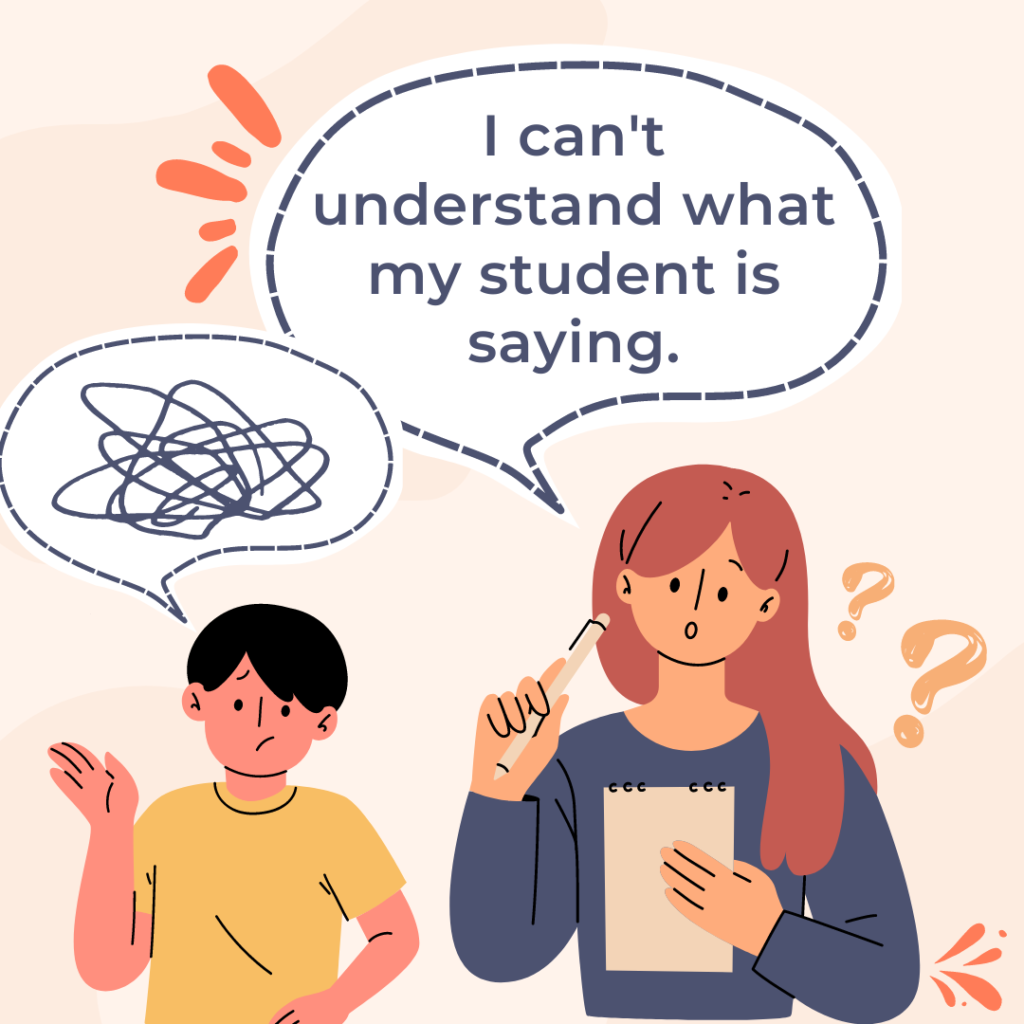
- Your student isn’t saying all the syllables in the word. When you model the word, does she say all the syllables? What if you break the word down into syllables? Is she able to repeat each syllable?
- Your student doesn’t say all the sounds in a word. Is the student familiar with the word, or is it a word she has never heard before? What happens if you ask her to repeat or if you model the word?

- During reading, your student doesn’t say all the sounds in his words…. Is the student able to identify all the alphabet sounds? Do you think your student is guessing what the word might be instead of sounding out the word?
What if the problem is related to misaligned teeth?
Whether the students exhibit some simple sound substitutions, phonological disorders, or more severe physical impairments that lead to speech problems (e.g., overbite, cleft lip or palate, etc.), it's important to show your teachers compassion.
If the speech pathologist suspects the student has dental misalignmenst, then they should recommend an orthodontist.
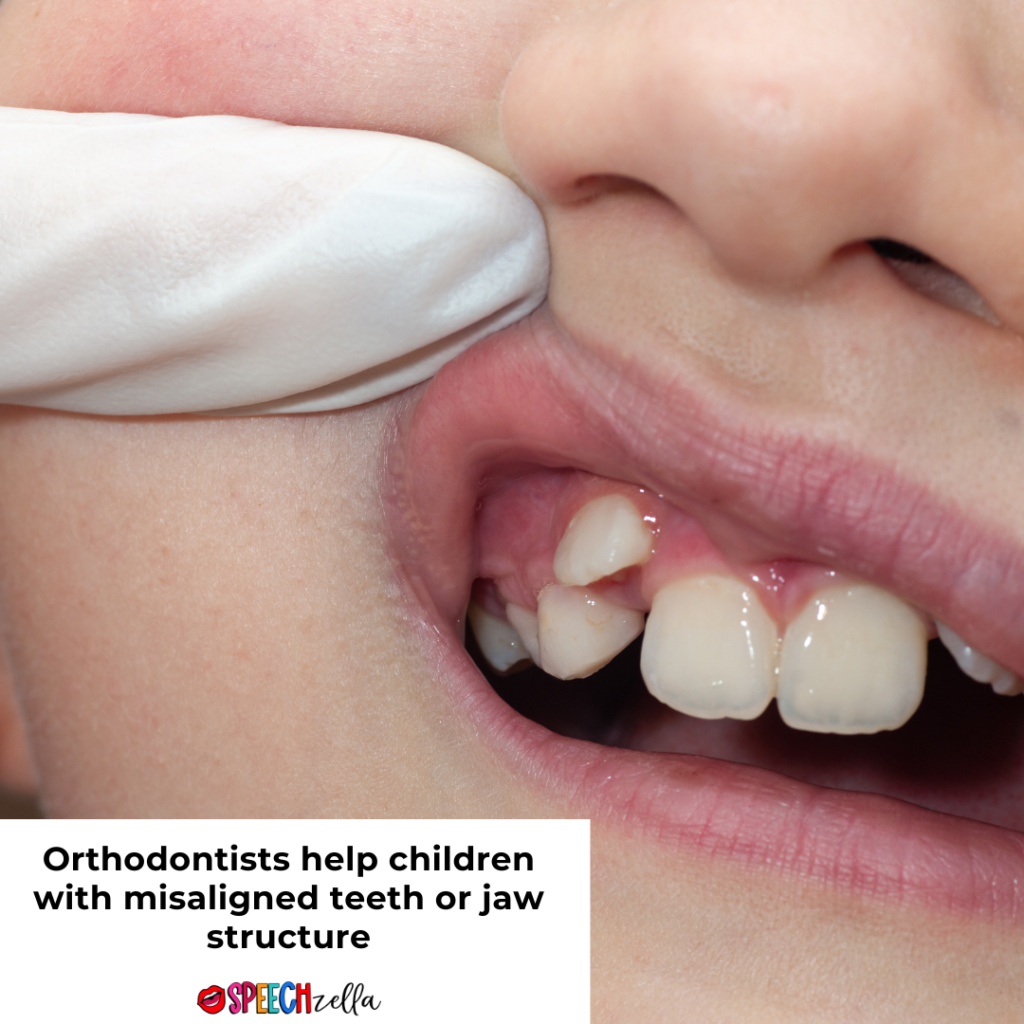
Orthodontists specialize in diagnosing, preventing, and treating dental irregularities that can affect speech, such as the teeth alignment and jaw structure.
Once the orthodontist evaluates the student, the speech pathologist needs to collaborate with them.
Sharing insights about the student's speech problems can help the orthodontist understand the broader context and change their treatment plan accordingly.
Stuttering (Fluency disorder)
Students who have difficulties with fluency present with multiple stuttering events during conversational speech or reading which impacts a person's ability to make their needs, wants, and thoughts known. The following are some scenarios that you might encounter:
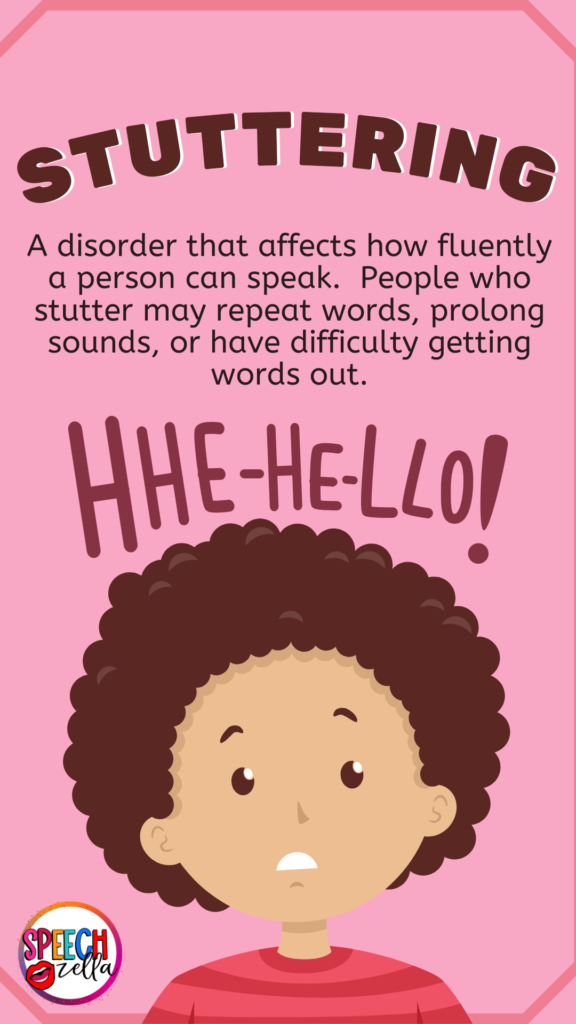
Sometimes, word finding difficulties look like stuttering. If a student is trying to think of the right vocabulary word, but can’t seem to recall the word from memory, they might have difficulties with language.
Stuttering looks different for every child.
Any problems with the rhythm of speech can be called stuttering.
Sometimes, stuttering is related to an anxiety disorder or there could be a family history of stuttering.
That's why it's so important to work with parents to make sure we get all the facts about the child from their family members.
Voice
Students who sound hyponasal or hypernasal, or have hoarse, scratchy voices might have a voice impairment.
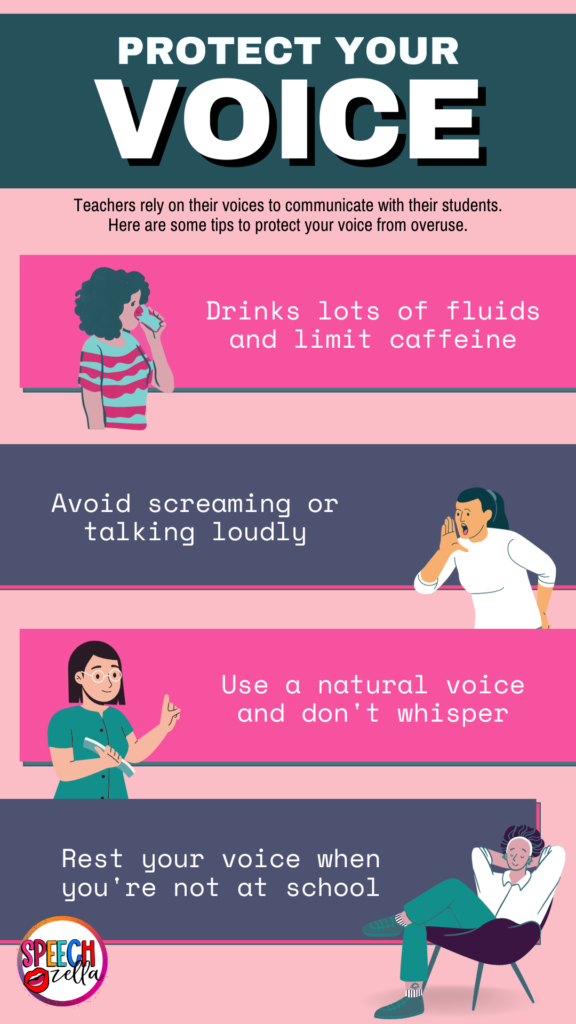
However, if a teacher approaches you with a concern, you should involve other professionals, such as otolaryngologists (ENTs) or allergists, to help determine the etiologies of their voice quality differences.
The ENT can place a small camera (i.e., endoscope) through the student's nose to observe the sinus and nasal passages.
The doctor can then determine if there are nasal polyps or tumors on the vocal cords (vocal folds), nasal blockages, velopharyngeal dysfunction, or vocal abuse and then decide on an appropriate treatment.
The allergist could determine if the student is presenting with allergies that are causing congestion or making students sound stuffy.
If a person's voice is affected, then you need to call any professional who can help make a diagnosis.
What are language disorders?
Language disorders, on the other hand, refer to difficulties with expressive or receptive language development.
Some students who have language disorders also have difficulties with social skills (i.e., pragmatics) or have diagnoses such as apraxia of speech, cerebral palsy, developmental delays, autism spectrum disorder, or other communication disorders.
Here are some of the common problems we see in students with language impairments or poor communication skills.
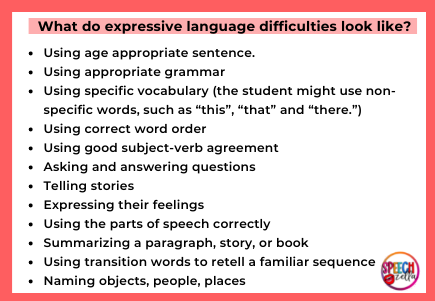
Expressive Language Disorders / Delays
The students who struggle with expressive language skills might struggle with the use of language and could present with the following communication problems (depending on the age).
They may not use the right words or have difficulty using age-appropriate sentences.
Here are some expressive language skills that might be affected by an expressive language disorder:
- Using age-appropriate sentences.
- Using appropriate grammar.
- Vocabulary (the student might use non-specific words, such as “this” and “that” instead of specific vocabulary).
- Word order.
- Subject-verb agreement.
- Asking and answering questions.
- Telling stories.
- Expressing their feelings.
- Summarizing a paragraph, story, or book.
- Retelling a familiar sequence using transition words.
- Naming people, objects, or places.
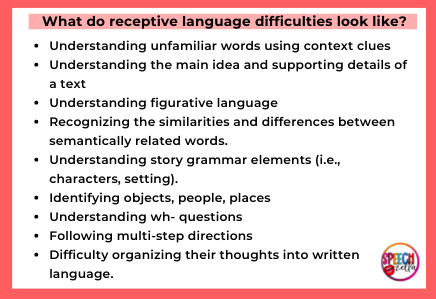
Receptive Language Delay / Disorder
Students who have receptive language disorders might have trouble understanding spoken language.
Here are some ways to tell if a student might have expressive or receptive language disorder.
Here are some receptive language skills that might be affected by a receptive language disorder:
- Understanding unfamiliar words using context clues.
- Finding the main idea and supporting details.
- Figurative language.
- Comparing / contrasting semantically related words
- Story grammar elements (e.g., characters, setting, etc.)
- Identification of people, objects, and places.
- Understanding wh- questions, such as “what” and “why” questions.
- Following multi-step directions.
- Organizing their thoughts into written language.
Speech vs. Language Freebie Library
If you need more fun and free speech vs. language activities, then check out my Canva freebie library exclusively for SLPs!

Activities to help teachers learn about speech vs. language disorders
The great news is that I have 7 free resources that give you various ways you can talk to teachers about speech and language disorders. These resources are perfect for a speech pathologist in-service or workshop and include a presentation, poster, infographic, and activity cards. Here are all the links to the resources:
Speech vs. Language Presentation
This speech vs. language presentation for Canva contains 18 slides to introduce your teachers to the differences between speech vs. language. The free presentation slides are animated and can be easily presented right from Canva. If you want to present using other platforms (i.e., Google Slides or PowerPoint), you can download the slides as PNGs and set them as the background in your favorite presentation style. These slides are completely editable and can be tailored to suit your needs. Personalize by inserting your name and contact info.
Included in this free presentation is the following information:
- What is speech therapy? Explains the difference between articulation, fluency, and voice disorders.
- What is language therapy? Explains the difference between expressive and receptive language disorders.
- Real life scenarios: Use these slides to talk about how you would approach each concern.
- Feel free to include any important related questions regarding special education services, related services, language milestones, or normal development.
- Let the teachers know about the child's communication needs!
Language vs. Speech Infographic
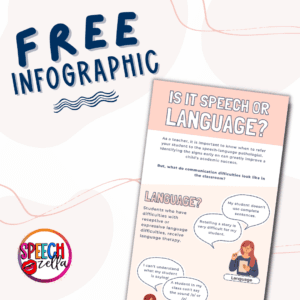
This infographic is the perfect visual to post around your school.
The infographic details the differences in speech vs. language disorders, then gives some possible scenarios that could occur in the classroom.
You can hang this handy infographic in your speech room or around your school so all the teachers can easily view it!
Add your contact information and more details about how to reach you if they have further questions. In Canva, you can edit all the text, colors, images and more! You can even add your own picture to the infographic so teachers know who they are contacting
Language vs. Speech Therapy Activity Cards
If you are conducting an in-service for your teachers, use these activity cards to enhance their learning!
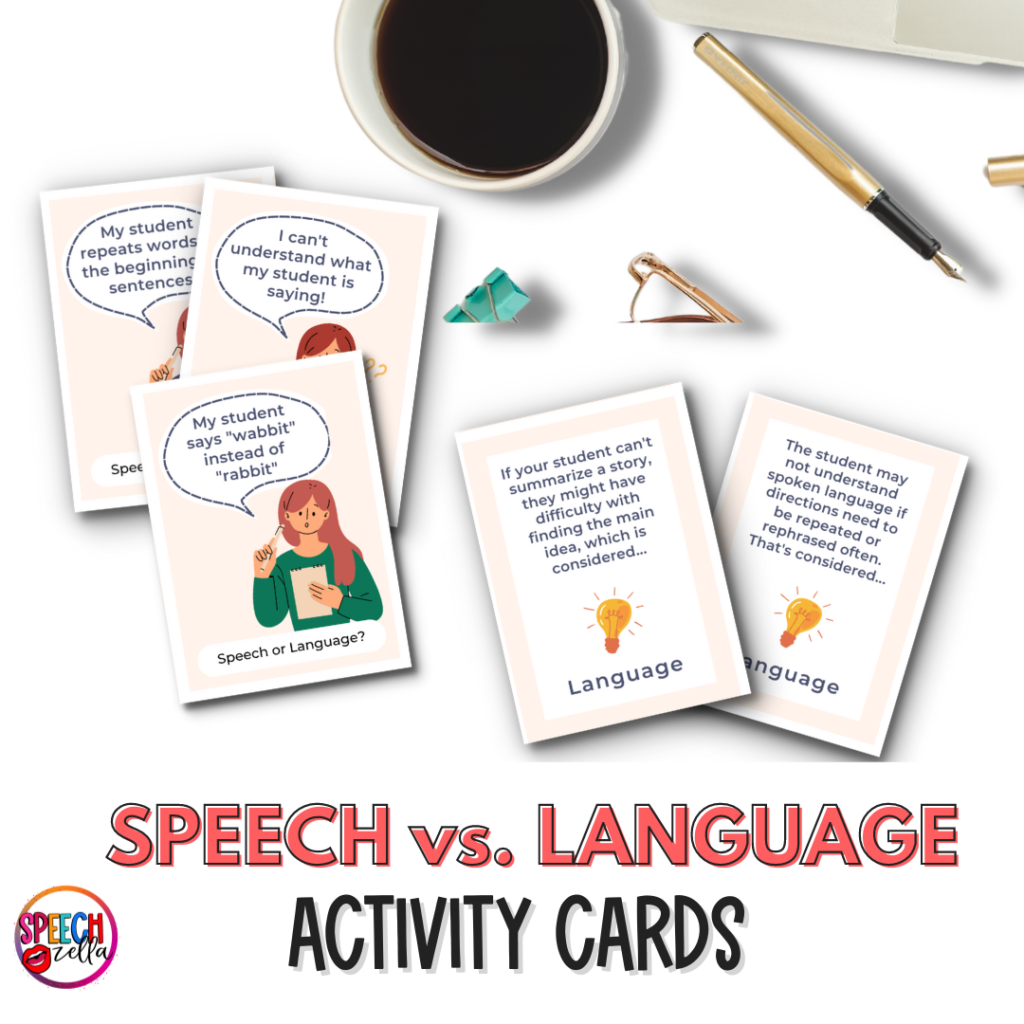
This set includes 6 language or sound disorder scenarios with possible teacher questions and answers.
You can add your own favorite scenarios to these 12 free flashcards.
After the presentation, then the teachers can split up into groups and try to match the scenario with the answer.
Lastly, the teachers disperse the cards and talk through the scenarios to find the correct response.
For durability, you can also laminate these cards.
There are so many ways you can use this activity in your presentation or in your classroom!
Language vs Speech Therapy Poster
If you need a poster to hang on your wall, then check out this language vs speech therapy poster. You'll get all the information you need in one place.
Hang this poster in your speech room or around your school during Better Hearing and Speech Month.

Get all the resources here!
If you want all the links to all three activities that you can use today, then click on the links below!
Help your teachers today to understand these differences so that more students can get the help they need early on!
- Speech vs. Language Presentation –> Speech vs. Language Presentation
- Language vs. Speech Activity Cards –> Language vs. Speech Activity Cards
- Language vs. Speech Infographic –> Language vs. Speech Infographic
- Speech vs. Language Presentation –> Speech vs. Language Presentation
- What is a Speech-Language Pathologist? –> What is an SLP?
- What is Stuttering? –> What is Stuttering?
- Voice Tips for Teachers –> Voice Tips for Teachers


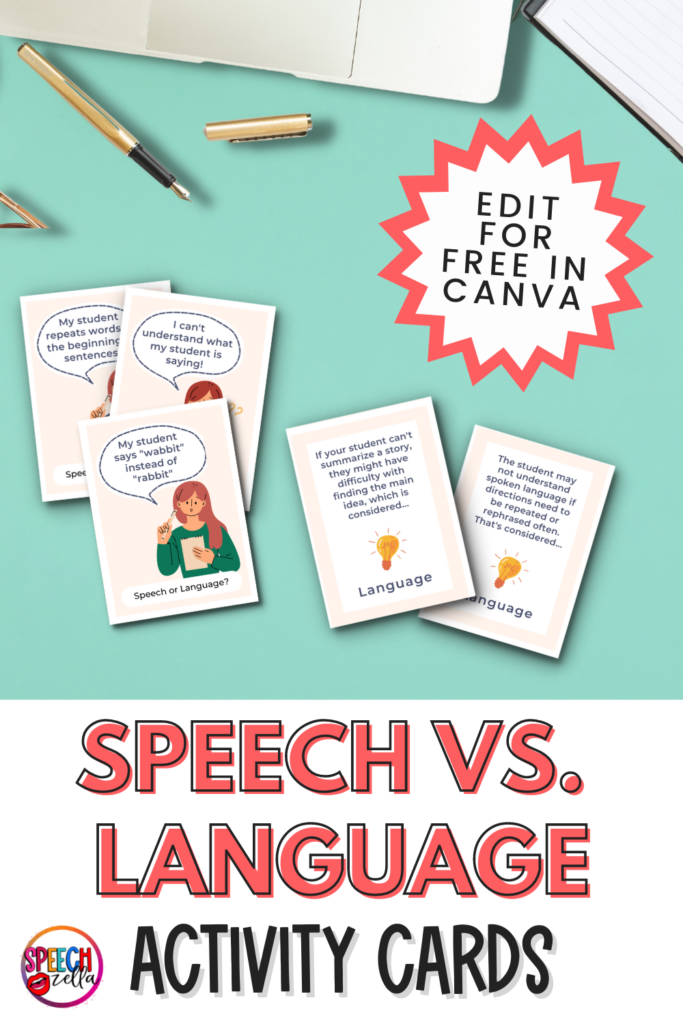
Stay Connected www.Speechzella.com – subscribe to get notified of new freebies!
- Canva Profile: https://www.canva.com/p/speechzella/
- TPT Store: https://speechzella.com/TPT
- Facebook: https://speechzella.com/facebook
- Instagram: https://speechzella.com/instagram
- Linktr.ee: https://speechzella.com/linktr.ee
- Boom Cards: https://speechzella.com/boomcards
If you have any questions about Canva and Canva for Education, check out these blog posts:
#canvaforspeechtherapy
You can make anything in Canva!

